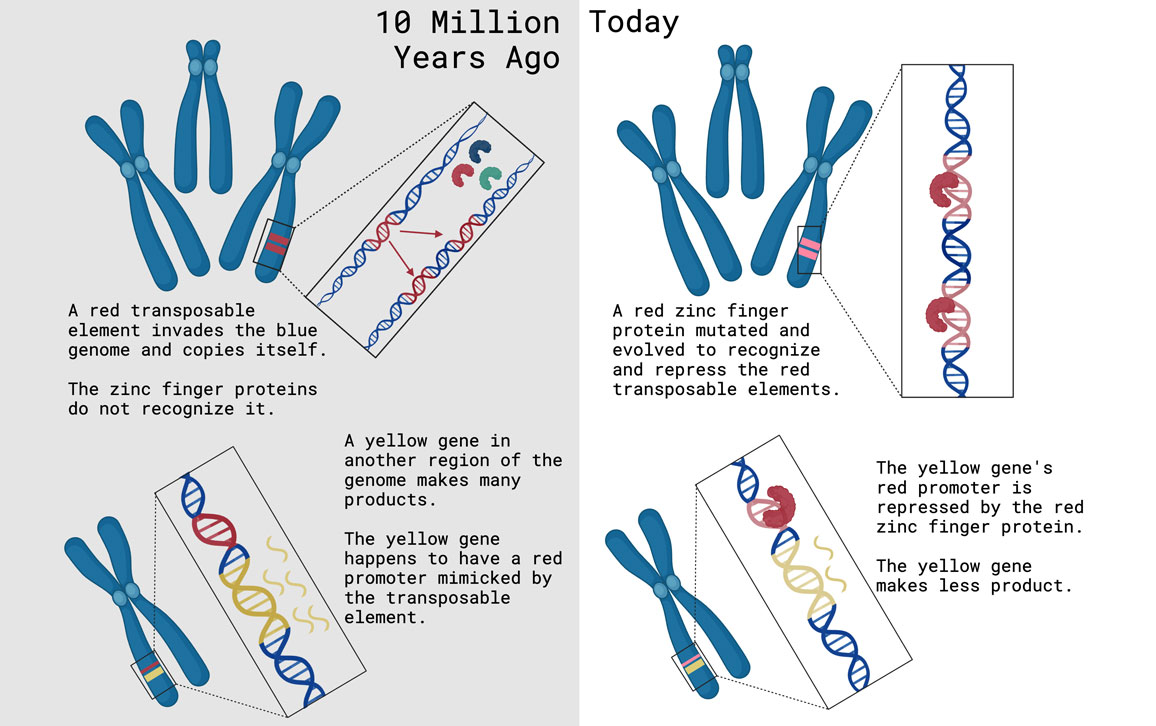Ancient Viruses Inadvertently Aided the Evolution of Primate Brains
By Hannah Kania
Genomes fighting off attacks changed the activity of ancestral neurons.
June 24, 2024
From The Staff Biology Evolution Medicine Anatomy Genetics Virology
Your genome harbors scars from a 100-million-year-old battle. For that entire span of time, genomes have struggled with attacks from viruses that target them, but they have developed ways to fend off damage, similar to how immune systems suppress infections. But over time, these neutralizing effects have had unintended consequences, and a new study points to clues about how these changes may have contributed to advances in primate intelligence.

Graphic by Hannah Kania, created with BioRender.com
When viruses attack, they have one goal: to make as many copies of themselves as possible. Cells in your immune system recognize specific viruses and multiply to fight their reproduction. Similarly, your genome employs fighters to defend itself against viruses that aim to use it to multiply.
Retroviruses are a kind of virus that can insert their genetic information directly into host genomes. Upon infection, retroviruses integrate into hosts as what are called transposable elements (TEs), or blocks of DNA that move and replicate across a genome. When retroviruses attacked ancestral mammalian genomes, their TEs were able to replicate rapidly because they adapted to mimic the look of specific genomic regions of the host called promoters, or DNA sequences that regulate whether a gene is turned on or off.
The genome fights back with its version of immune cells, proteins that are called KRAB zinc fingers. These KRAB zinc fingers neutralize TE attacks by binding to them, either before they are able to latch onto the genome or after they have integrated.
“KRAB zinc fingers recognize and repress transposable elements. They make sure that they cannot jump anymore, so they cannot copy-paste themselves in the genome,” says Frank Jacobs, a professor of evolutionary neurogenomics at the University of Amsterdam and lead author of the study.
Although the ancient, immobilized TEs are no longer a threat to modern genomes, these degraded TEs can still be seen today in genomes, like wreckage on a battlefield. Indeed, ancient TEs make up about half of every human genome. Ancestral genomes successfully mitigated further struggle with the ancient TEs, but the final defensive move may have had some unpredictable effects for the lineage of animals that would generate great apes and modern humans.
After millennia of defending genomes from host-mimicking TEs, KRAB zinc fingers today can also target some legitimate promoters that TE invaders mimicked. This neutralization modifies the legitimate promoters’ effects on nearby genes, forcing the promoters and genes to respond to regain stability. Jacobs and his team have found evidence that these responses may have effected the evolution of modern primate brains.
Jacobs and his team study the knock-on effects of promoters neutralized by KRAB zinc fingers. In a recent study published in Genome Biology and Evolution, they describe their findings that that sometimes a gene may benefit from its promoter being bound by a defensive KRAB zinc finger, because turning the gene’s activity down may help to regulate an important process. The promoter will evolve to have a tighter bond with the protein.
However, at other times this binding could be detrimental, because turning the gene’s activity down may mess with an important existing pathway, and the promoter will evolve mutations to weaken the bond.
The researchers hypothesized that promoter evolution to either tighten or weaken KRAB zinc finger bonds would lead to increased mutations in the DNA code at those regions. Such accumulated mutations would either make promoter regions less similar to the TE invaders, and thus camouflaged from the defensive proteins; or more similar to the KRAB zinc fingers, and thus easier to bind. Indeed, their results showed that the DNA code at promoter regions bound by KRAB zinc fingers is scrambled as the promoters have grappled back and forth over time to tighten and loosen these bonds.
Once the researchers confirmed that promoters vary in their responses to KRAB zinc fingers, they took a closer look at KRAB zinc fingers that are specific to primates. Researchers used laboratory-grown tissues to look at the activity of genes in the presence and absence of three KRAB zinc finger proteins found only in primates.
The team found that when the primate KRAB zinc fingers were removed from the model tissues, genes associated with neurons were turned on more often than normal. This change means that the KRAB zinc fingers normally tune down neuronal genes, because the genes are more active when the proteins are gone. Over time, primate neuronal gene promoters evolved tighter bonds with these proteins, likely because tuning down neuronal genes was beneficial in primate evolution. This finding suggests that the evolution of primate brains is responding to this ancient viral battle. Genes associated with neurons and the brain have evolved a unique relationship with KRAB zinc fingers, one that is only found in primates so far.
Unexpectedly, one of the investigated KRAB zinc fingers binds to neuronal gene promoters that are associated with what are called repeat expansion disorders. These neurological disorders include Huntington’s disease and Fragile X-syndrome in humans. Jacobs and his team intend to continue investigating KRAB zinc finger interactions to understand their full effect on primate brain evolution, from neurological innovation to neurological disease. They hope to unpack the long-term genomic effects from ancient viral battles and the unintended consequences of host defense mechanisms.
“These viruses have this long-lasting impact,” says Jacobs. “Our genes are still trying to find a new balance. While these ancient invasions ceased even before the old-world monkeys split off, this continuing optimization of gene regulation is not done yet.”
American Scientist Comments and Discussion
To discuss our articles or comment on them, please share them and tag American Scientist on social media platforms. Here are links to our profiles on Twitter, Facebook, and LinkedIn.
If we re-share your post, we will moderate comments/discussion following our comments policy.